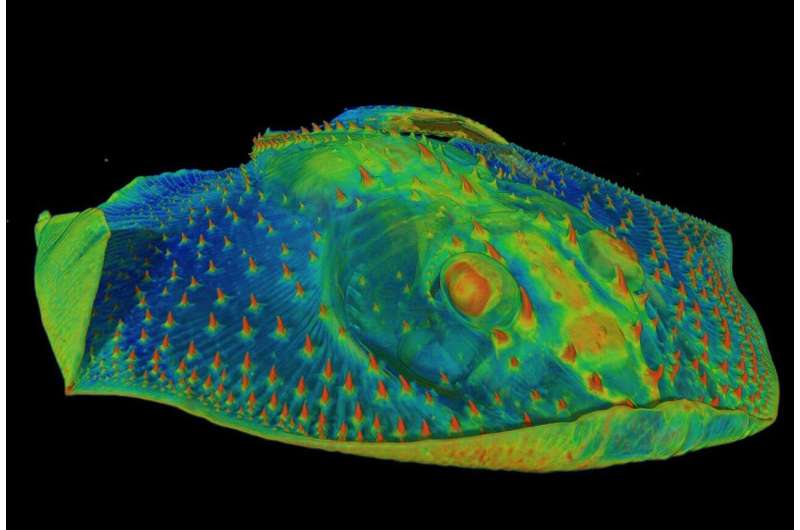Scientists have discovered that vertebrate teeth originally evolved as sensory organs rather than just tools for eating, according to new research published in Nature that examined fossils dating back 470 million years.
The study used cutting-edge synchrotron scanning technology to reveal that the earliest tooth-like structures in ancient fish were designed to detect environmental changes, much like modern touch sensors. This finding overturns a long-standing scientific controversy and pushes back the origin of true vertebrate dental tissue by 40 million years into the Middle Ordovician period.
The research team from the University of Chicago, Harvard University, and other institutions made their discovery while investigating controversial Cambrian fossils previously thought to represent the earliest vertebrate teeth. Instead, they found these ancient structures belonged to arthropods—relatives of modern crabs and insects.
A Case of Mistaken Identity
For decades, paleontologists have debated fossils called Anatolepis heintzi, which some researchers claimed were the earliest vertebrate remains containing dentine—the tissue that forms the bulk of modern teeth. These 500-million-year-old fragments appeared to have the characteristic tubular structures found in vertebrate dental tissue.
Using powerful synchrotron X-ray tomography at Argonne National Laboratory, the research team discovered that these supposed dental tissues were actually sensory structures from ancient arthropods called aglaspidids. The tubules previously identified as dentine turned out to be sensory organs similar to those found in modern crabs and other arthropods.
The misidentification occurred because both vertebrate teeth and arthropod sensory organs evolved remarkably similar internal structures. Both feature branching tubules radiating from central cavities, creating what scientists call “convergent evolution”—when unrelated organisms develop similar features to solve comparable problems.
Real Vertebrate Teeth Finally Found
With the Cambrian contenders eliminated, the researchers turned to Middle Ordovician fossils from 470 million years ago to find genuine vertebrate dental tissue. They examined tooth-like structures called odontodes from ancient fish species Eriptychius and Astraspis found in Wyoming’s Harding Sandstone.
These early vertebrate teeth showed clear signs of sensory function. Eriptychius odontodes lacked the protective enamel coating found in later teeth, leaving dentine tubules exposed to the environment—a feature that would cause extreme sensitivity in modern animals. The structures also maintained open pulp cavities connected to the nervous system.
Modern Evidence Supports Ancient Function
To test whether this sensory function persists today, researchers examined external tooth-like scales in modern fish using advanced immunofluorescence techniques. They studied juvenile catsharks, little skates, and bristlenose catfish, finding extensive nerve networks associated with these structures.
The analysis revealed that modern fish retain significant innervation in their external odontodes—the evolutionary predecessors of teeth. In catfish, nerves actually penetrate the pulp cavities of fin scales, while in sharks, nerve networks surround the base of body scales.
Key Research Findings
- Cambrian fossils previously thought to be earliest vertebrate teeth actually belonged to arthropods with sensory organs
- True vertebrate dental tissue first appeared 40 million years later than previously believed
- Early vertebrate teeth showed clear adaptations for sensory function rather than just feeding
- Modern fish retain extensive innervation in tooth-like scales, supporting the sensory evolution theory
- Convergent evolution produced remarkably similar structures in vertebrates and arthropods for sensing environmental changes
Why Sensory Teeth Make Evolutionary Sense
The sensory origin of teeth helps explain several puzzling features of modern vertebrate biology. Why are teeth so exquisitely sensitive to pain? Why do some animals like narwhals have teeth that function primarily as sensory organs? The answer may lie in their evolutionary history as environmental sensors.
For early vertebrates encased in bony armor, maintaining sensory contact with the environment would have been crucial for survival. Tooth-like structures provided a solution—they could offer protection while simultaneously gathering information about water chemistry, food quality, and potential threats.
This “sensory armor” concept extends beyond vertebrates. Modern arthropods use similar structures for environmental sensing, suggesting this was a widespread evolutionary solution to the challenge of maintaining awareness while staying protected.
Technological Breakthrough Enables Discovery
The research was only possible because of advances in synchrotron X-ray technology that can reveal internal structures without destroying precious fossils. The team scanned 35 different species, both extinct and living, to build a comprehensive database of skeletal tissues.
The high-resolution scans revealed details invisible to previous microscopy techniques, including the distinctive “tube-in-tube” structure of arthropod sensory organs that differs from genuine vertebrate dentine. This level of detail allowed researchers to definitively distinguish between the two tissue types.
Implications for Understanding Life
This discovery reshapes our understanding of how complex sensory systems evolved in early animals. Rather than developing feeding structures that later gained sensitivity, vertebrates appear to have evolved sensory systems that were subsequently adapted for food processing.
The finding also highlights how convergent evolution can fool even expert scientists. When similar environmental pressures act on different lineages, the resulting solutions can be virtually indistinguishable without sophisticated analysis tools.
As researchers continue studying the vast archive of ancient life preserved in fossils, such technological advances promise to reveal more surprises about how fundamental biological systems evolved. What other assumptions about early life might advanced imaging techniques overturn?
The research demonstrates that even our most basic features—like teeth—have evolutionary stories more complex and fascinating than previously imagined.
Discover more from Wild Science
Subscribe to get the latest posts sent to your email.

